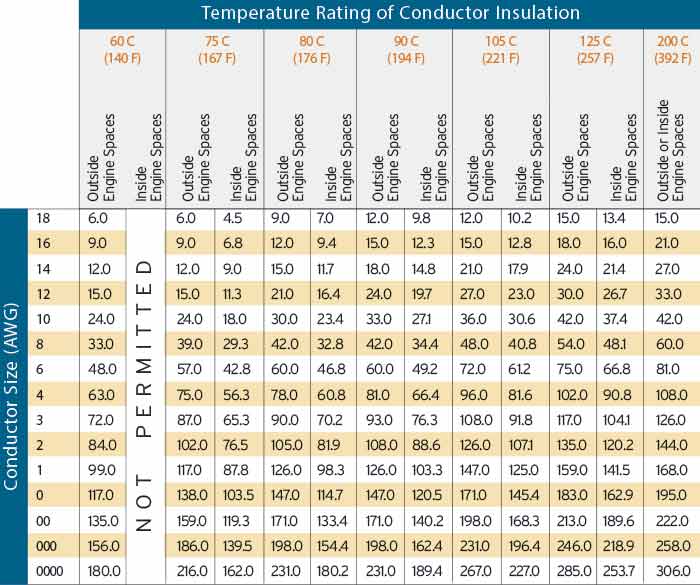Inverter to battery bank cable
luqman
Registered Users Posts: 15 ✭✭
Hello, If anyone could support me in sizing the cable from the inverter to the battery bank.
My inverter is 5KW and my battery bank is an 840 AH forklift battery at 48V, Also fuse size.
regards
luqman
My inverter is 5KW and my battery bank is an 840 AH forklift battery at 48V, Also fuse size.
regards
luqman
Comments
-
How long will the battery bus to inverter be?
A conservative sizing:- 5,000 Watts * 1/0.85 inverter eff * 1/42 volts low battery cutoff = 140 Amps max continuous
- 140 Amps * 1.25 NEC derating for fuses/breakers/wiring if continuous current (vs minutes at 5 kW) = 175 Amp Branch circuit breaker/wiring derated
https://lugsdirect.com/WireCurrentAmpacitiesNEC-Table-301-16.htm
Depending on insulation type (temperature rating) ~ 2/0 cable would be nice (and safe).
Then there is sizing the cable for the cable run length (this website uses "one way" cable run lengths). Suggest a maximum of 2 volts wiring drop for 48 volts from inverter to battery bank/bus. Ask if 2/0, 2 volt drop, 5 feet for 2/0 cable--What is voltage drop:
https://www.calculator.net/voltage-drop-calculator.html?necmaterial=copper&necwiresize=6&necconduit=steel&necpf=0.85&material=copper&wiresize=0.2557&resistance=1.2&resistanceunit=okm&voltage=48&phase=dc&noofconductor=1&distance=5&distanceunit=feet&eres=140&x=57&y=23&ctype=size
Voltage drop: 0.11
Voltage drop percentage: 0.23%
Voltage at the end: 47.89
2/0 is very low voltage drop @ 140 amps -- So perfectly OK in terms of voltage drop.
Remember you have some wiring to interconnect batteries or cells to the bus bar. So a bit of extra length there.
-BillNear San Francisco California: 3.5kWatt Grid Tied Solar power system+small backup genset -
@BB.
Hi bill, the distance from the battery to the inverter will be about 2-3 feet -
Even better (shorter length). Keep +/- wires bundled together (if they loop separately, they act more like an antenna and can better broadcast electrical noise and "receive" lightning energy).
Just to give you a "less conservative" wire sizing chart:
https://www.boatus.com/expert-advice/expert-advice-archive/2020/february/choose-the-correct-wire-size
You could go "smaller" AWG wire size using the boating/marine standards (even down to 2 SAE Gauge) (also based on insulation temperature rating).
Note, our/my suggested max voltage drop is much less from charger to battery bus... On the order of 0.2 to 0.4 volt max for 48 volt battery bus (0.05-0.10 for 12 volt and 0.1 to 0.2 for 24 volt buses). You want "accurate" battery voltages for accurate/fastest charging.
And the derating of fuses/breakers... In North America, generally fuses and breakers are rated to "not trip" at 0.80 of rated load, and "eventually trip" at 1.00 of rated load... So, if you have a chance for 5kWatt loads (AC loads, or even AC to DC charging), the 1.25 (or 1/0.80=1.25) NEC derating for continuous current will help prevent "false trips" of breakers and fuses during sustained high currents.
Regarding fuses and breakers--There are differences between AC rating and DC ratings for switches/fuses/breakers... Generally DC current (over ~12 volts) is much harder to "interrupt" vs AC current (i.e., arcs sustain very nicely with DC currents)--So always make sure the switches/fuses/breakers are rated for the AC vs DC voltages you want to "control".
-BillNear San Francisco California: 3.5kWatt Grid Tied Solar power system+small backup genset -
@BB. thank you very much, you have really helped me
Categories
- All Categories
- 233 Forum & Website
- 141 Solar Forum News and Announcements
- 1.4K Solar News, Reviews, & Product Announcements
- 199 Solar Information links & sources, event announcements
- 900 Solar Product Reviews & Opinions
- 256 Solar Skeptics, Hype, & Scams Corner
- 22.5K Solar Electric Power, Wind Power & Balance of System
- 3.5K General Solar Power Topics
- 6.7K Solar Beginners Corner
- 1K PV Installers Forum - NEC, Wiring, Installation
- 2.1K Advanced Solar Electric Technical Forum
- 5.6K Off Grid Solar & Battery Systems
- 429 Caravan, Recreational Vehicle, and Marine Power Systems
- 1.1K Grid Tie and Grid Interactive Systems
- 656 Solar Water Pumping
- 816 Wind Power Generation
- 624 Energy Use & Conservation
- 623 Discussion Forums/Café
- 315 In the Weeds--Member's Choice
- 75 Construction
- 125 New Battery Technologies
- 108 Old Battery Tech Discussions
- 3.8K Solar News - Automatic Feed
- 3.8K Solar Energy News RSS Feed
